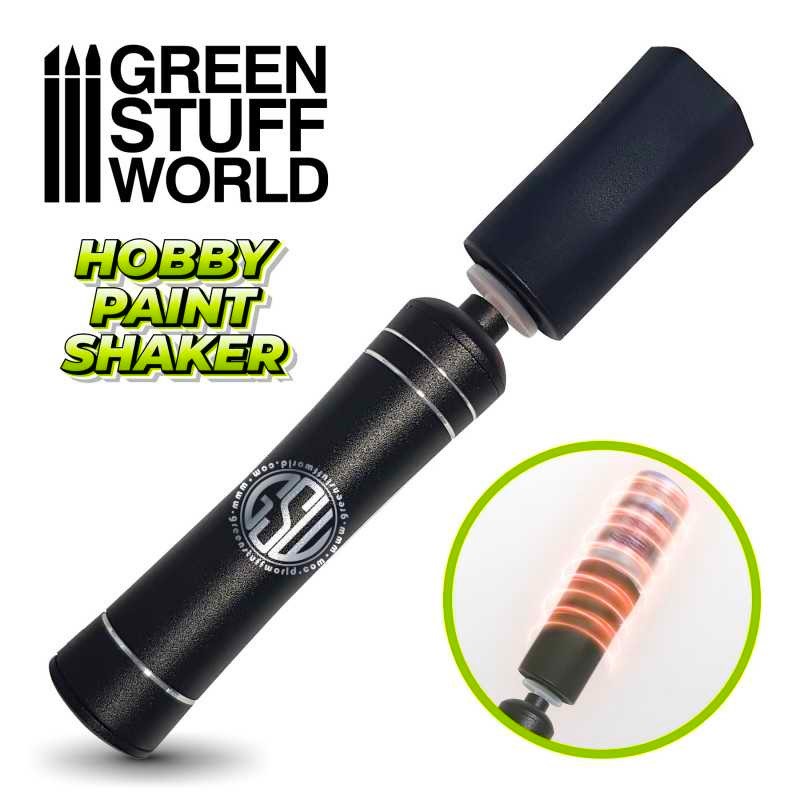Have you ever experienced the frustration of squeezing out acrylic paint from a tube or bottle, only to find it looking a little…off? Maybe the color seems different, or the texture is unexpectedly thick and gloopy in some spots while thin and watery in others. Don’t worry, you’re not alone.
Many artists have to deal with the fickle nature of acrylic paint. So, why does our paint rebel against us? Well, one reason could be that the pigments have settled to the bottom of the tube or bottle, causing the color to appear different. This is where a paint shaker can come in handy. By vigorously shaking the paint, the pigments will mix together again, resulting in a more uniform consistency.
The Science Behind Acrylic Paints
Acrylic paints seem simple enough at first glance. Essentially, it’s pigment (the stuff that gives it color) mixed into a polymer binder that allows it to stick to surfaces. Add in a few stabilizers and thickeners and voila, paint!
But keeping all those ingredients playing nicely together can be tricky. Over time, they tend to drift apart, especially if the paint has been sitting unused for a while.
It’s Just Chemistry
The polymers, usually some form of acrylic resin, are lighter than the dense mineral pigments. So gravity takes over, with the pigments slowly sinking to the bottom of the bottle. This settling leaves you with funky color variations if you don’t re-mix it.
Other ingredients like stabilizers and thickeners can also separate out. And air bubbles can work their way in. Suddenly, your creamy, uniform paint becomes a chemistry experiment gone wrong.
Traditional Mixing Methods: Effective But Tedious
In the past, artists had two choices for re-mixing separated paint – shaking by hand or stirring with a tool. A good long shake will eventually get things blended again. But it’s tiring for our wrists and shoulders to shake bottle after bottle this way.
Using a paddle or stick to stir works too, but risks introducing more bubbles. It’s also time-consuming if you have a lot of paint to mix. And it doesn’t fully reach into every nook and cranny the way shaking does.
The Magic of Rotational Paint Shakers
Enter the acrylic paint shaker, a game changing tool for artists and manufacturers alike. Let’s explore what makes these machines so magical.
Spinning Progress
In a rotational shaker, the paint bottles are placed horizontally onto a rotating platform or wheel. As it spins rapidly, centrifugal force blends all those separated components together again. It’s like an amusement park ride for paint!
Most shakers have variable speed settings, allowing control over the intensity. Slow, steady spinning works great for gently remixing paint without introducing bubbles. Crank it up for a deep, clean blending when the paint has fully separated.
Gentle Yet Thorough
Shaking by hand rigorously can cause several issues. It whips tiny air bubbles into the paint that leave an uneven finish when brushed on. And all that force can degrade the polymers, affecting the paint’s viscosity and performance.
The rotational shaker’s gentler motion avoids aeration and protects the paint’s composition. Yet it still fully integrates the ingredients corner to corner for consistent coverage.
A Time Saver
Artists mixing large volumes of paint benefit the most. Hand shaking every bottle and tube in your collection takes forever and can cause hand cramps and shoulder fatigue. Letting a machine handle that grunt work is a welcome relief!
For paint manufacturers producing gallons of the stuff, paint shakers are necessary to maintain product quality from batch to batch.
Benefits for Acrylic Paint Users
Convinced yet that a rotational paint shaker deserves a spot in your artistic toolbox? Here are some key benefits this ingenious device brings to the table.
Consistent Colors and Textures
Properly mixed paint can eliminate these annoyances. Paint shakers are designed to blend pigments and polymers so uniformly that you get reliable coverage every time. With paint shakers, you can achieve consistent color and texture, and say goodbye to unexpected variations.
Longer Lasting Paint
The denser pigments tend to settle on top of the polymers, causing damage to them. This not only affects the shelf life of your paint but also its performance. A quick spin in the shaker can save you from all these troubles. It mixes everything up and prevents the pigments from settling. This ensures that your paint lasts longer in the bottle and performs better on canvas or paper.
Save Your Wrists
There is a solution that can take over this tedious chore for you. Paint shakers are a great tool for minimizing inflammation and joint issues caused by manual paint shaking. With a paint shaker, you can wave goodbye to sore shoulders and cramping hands, making the process of mixing paint a more comfortable and efficient experience.
Finally
You may want to consider using a paint shaker to avoid having gritty and separated acrylics when painting. With a paint shaker, you won’t have to guess how much paint you need to squirt onto your palette. Instead, you will have pure and vivid colors that will blend seamlessly on your canvas.
Using a paint shaker will also relieve the strain on your wrists, while your acrylic paintings will look more professional than ever before, thanks to the perfectly mixed paint. Investing in a paint shaker is a wise decision for any artist who wants to elevate their artwork.
FAQs
Q: Are paint shakers safe to use with all types of acrylic paints?
A: Yes, paint shakers are safe for most acrylic paint brands including heavy-body, fluid, and soft-body paints. The exceptions would be paints with large glitter or particles added, as the shaking action could damage those. Always check the paint label for any special instructions.
Q: How long should I shake my acrylic paints for?
A: The time needed will vary based on the amount and consistency of the paint. A general guideline is 2-5 minutes for most bottles. Heavily separated paint may require longer, around 10 minutes. Observe the paint as it mixes and stop when it regains a uniform consistency.
Q: Can I reuse old acrylic paints that have fully separated?
A: Yes, a good shaking can often revive old, separated acrylics for reuse. The key is to shake them for longer to fully re-integrate the pigment and polymers. Just be aware that very old acrylics may have degraded and not perform as expected even after shaking.
Q: What speed setting should I use on a rotational paint shaker?
A: Start on a low to medium speed setting first for gentler mixing. If the paint still seems separated, gradually increase the speed in increments up to the maximum setting to achieve the desired blending. Higher speeds mix faster but can potentially introduce air bubbles.
Q: Will acrylic paint settle again after shaking?
A: Unfortunately yes, acrylic paint will eventually re-settle due to the natural separation of the ingredients. However, a periodic shake every few months will usually keep it freshly mixed. Store paint bottles vertically upside down to help slow settling after shaking.





Leave a Reply